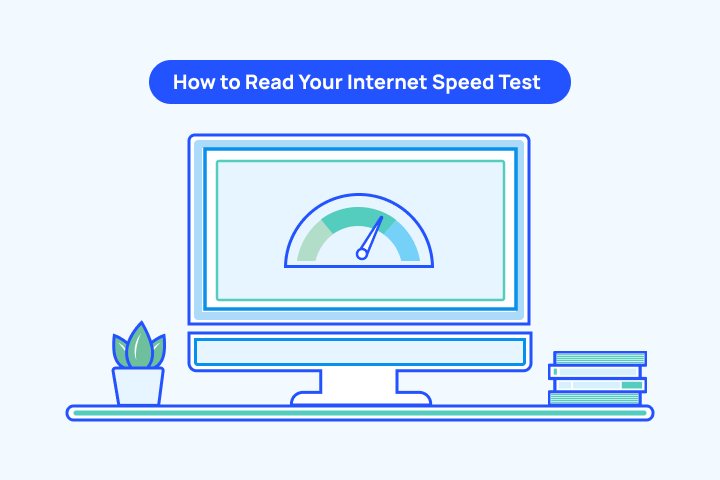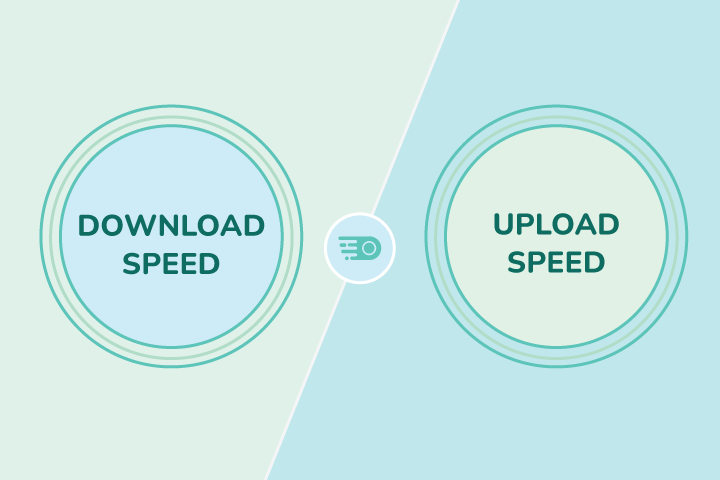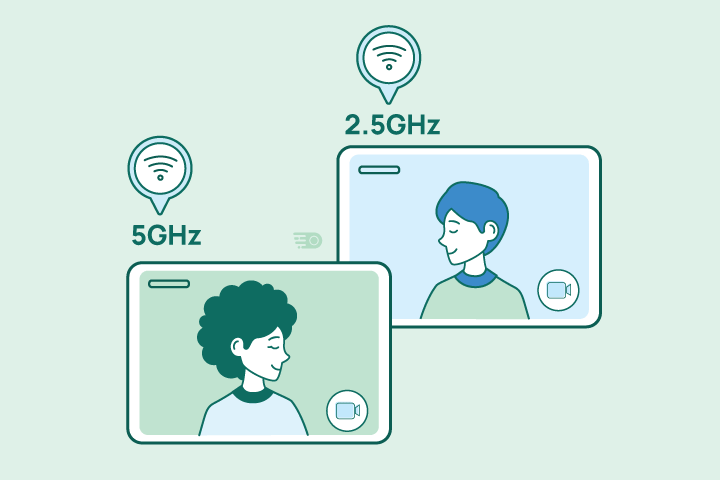How to Read an Internet Speed Test

HighSpeedOptions prides itself on providing honest, quality content. While we may be compensated when you make a purchase through links on our site, all opinions are our own. Here's how we make money.
Table of Contents
Nothing disrupts life quite like slow internet. This is more evident today than it was even a decade ago since internet service is now an essential household utility.
If you’re experiencing sub-par internet speeds, you’re not alone. Yet, rather than bang on your computer or throw your shoe at your buffering TV, consider running an internet speed test. It is the first step to assessing what’s wrong with your connection and finding a solution fast.
Key Takeaways:
- Running an internet speed test helps diagnose issues with your internet connection.
- Learn what each result means (Download, Upload, Ping, Jitter, Packet Loss).
- Compare your actual speeds to your provider advertises.
- Identify common factors that may slow down your internet connection (equipment, congestion, devices).
- Use the results of your speed test to upgrade your internet.
Got Slow Internet? Call us today and we’ll help you find the best service in your area.

What is an internet speed test?
A speed test measures how fast your internet is in real-time at that particular moment. (Yes, your internet speed can vary throughout the day.) It’s easy to access and takes less than a minute to complete.
The test displays statistics about your internet connection, including your download speed, upload speed, ping time, and IP address. These gauge the performance of your current connection and confirm whether the speeds you pay for actually meet your expectations. Keep in mind that our test results may vary day to day.
Typically, internet providers advertise their network’s fastest possible speeds. So don’t be surprised if your test results vary day to day and come in slightly lower. Besides your provider, additional factors affect your internet experience. But before we discuss them, let’s touch on the data measured with speed tests.
Reading Your Speed Test Results
After your speed test is complete, you’ll see values for your download speed, upload speed, ping time, and sometimes jitter.
Download Speed
This is a measurement of how fast your device receives data from the internet. Online activities like streaming your favorite shows or scrolling through social media require download speeds.
Upload Speed
This measures how fast your device sends data to one of your internet provider’s servers. Online activities like posting photos to Instagram or uploading a file to the cloud require upload speeds.
Ping Rate
Ping measures how quickly a data packet travels to a server and back. A low ping value means that your connection is fast and responsive. A high ping (over 100 ms) can cause lag during video calls, online gaming, and other real-time activities.
Jitter
Jitter is the variation in ping times. A stable connection should have consistent ping results. High jitter creates disruptions, making video calls choppy and online games unstable.
Packet Loss
Packet loss occurs when data packets fail to reach their destination. This reduces overall connection quality. Common symptoms include missing words in a call, buffering video, or sudden disconnections.
Advertised vs Actual Speeds
Internet providers always advertise their network’s fastest speeds; however, people rarely reach full capacity when accessing the internet. And the only way to achieve that speed is through a wired connection to your modem or router. Wireless connections fluctuate based on physical obstructions and your distance from the router. A wired connection provides consistency and maximum speeds.
In general, your internet speed test should be no more than five to ten percent below your top speed.
Many factors can affect the quality of your internet connection. Below, we list the top reasons for slow internet that you may be able to fix before calling your internet provider for help.
Reasons for Slow Internet
Check out our slow internet connection guide that covers causes and solutions in detail. For now, here are the most common causes of slow internet.
Equipment Location
The top reason for slow internet is equipment location. Routers and modems need space to perform at their peak capacity, so avoid placing them on the floor, near other cords, behind furniture, or in a cabinet. It’s best to put your router in the center of your home, on the highest level or furniture perch, as the Wi-Fi signal travels downward.
Takes about 10-15 mins.
Router Maintenance
Electronics need regular maintenance to function optimally. Restart your modem and/or router to reset operations and refresh connections. We recommend doing this monthly by setting a reminder on your phone or using an outlet timer to automate the task.
Takes about 5 mins.
Too Many Connected Devices
The more devices that are connected to your network, the more your router has to process and manage, which diminishes its performance. To avoid this, disconnect unused devices to conserve bandwidth and maximize internet performance. Setting up a guest Wi-Fi network is a great way to give visitors internet access and easily manage temporary, unwanted connections.
Takes about 5-10 mins.
Network Congestion
When too many people in your area are online at the same time—usually during peak evening hours—your internet speeds can slow down. This happens when multiple households share the same network resources, creating congestion—similar to rush-hour traffic. While you can’t control how many of your neighbors are streaming or gaming, you can work around it. Try scheduling heavy internet use (like large downloads, video calls, or streaming in 4K) during off-peak hours, such as early mornings or late evenings, to get more consistent speeds.
Takes about 0 mins (just a timing adjustment).
The Importance of Running a Speed Test
Since your online activity works best with fast speeds and low latency, we recommend testing your internet connection monthly to monitor its performance. We list the main benefits below:
Keep Your Internet Provider in Check
The main reason for running a speed test is to compare your actual speed to the advertised speed from your internet provider. While it’s normal for speeds to perform slightly lower than advertised speeds, you should still be within no more than 100 Mbps of your paid plan. If you find that your speeds are consistently too low, this information can help you when contacting your ISP. In some cases, providers will offer discounts, reduced rates, or same-day technician support to resolve your issue. Never pay for poor service if you can help it.
Find the Best Times to Get Online
Avoid accessing the internet, or at least minimizing high-demand activities, during evening peak hours. We get it, evenings are when you watch Netflix or game online. This would be a good time to optimize your home network using the suggestions above to help counteract network congestion. Your speeds may be faster during early mornings and weekdays when fewer people are online. Run a speed test at different times throughout the day to find when it performs best.
Assess Your Internet Speed Needs
Regularly testing your internet connection can help you decide what speeds are right for your lifestyle, not just when you’re experiencing internet sluggishness. It’s important to check it a couple of times a month to ensure you’re getting the expected speeds from your provider. You can also take our quick internet speed quiz to confirm you have the ideal internet plan for your needs. If your connection is consistently slow, you may need to upgrade your internet plan. As your habits change, so will your internet needs.
The Speed You Need
Knowing what speed your household needs is helpful to compare with your speed test results. Is it time for an upgrade?
How Much Speed Do I Need?Stay in Control of Your Internet Speeds
Running an internet speed test is one of the simplest ways to take charge of your connection. By understanding your results and knowing what factors affect your speeds, you can troubleshoot issues, hold your provider accountable, and decide when it’s time to upgrade. Consistently testing ensures you’re getting the performance you pay for—and the speeds you need to stream, work, and connect without frustration.
If slow internet is holding you back, enter your ZIP code below to explore your options and find the provider and plan that delivers the reliability your household deserves.
Reading an Internet Speed Test Frequently Asked Questions
The easiest way to test your internet speed is by using a trusted broadband speed test tool. Simply visit TestMySpeed.com, click the “Start Test” button, and wait less than a minute for your results. The test will measure your download speed, upload speed, and ping to give you a clear picture of your connection performance.
A broadband speed test measures the real-time performance of your internet connection. It evaluates how quickly data can be downloaded and uploaded between your device and a remote server. Running a test helps identify whether you’re getting the speeds your provider advertises or if something is slowing your connection down.
You can check internet speed on most devices—computers, smartphones, or tablets—using any browser. Just open an internet speed test website or app and run the test while connected to your Wi-Fi or wired network. To get the most accurate results, connect your device directly to your modem with an Ethernet cable.
Connection speed can vary depending on factors like network congestion, Wi-Fi signal strength, or the number of devices connected. Speeds often dip during peak evening hours when many people in your area are online. Running multiple tests at different times can help you spot patterns in your internet performance.
Download speed shows how fast your device can receive data from the internet. It’s the most important factor for streaming movies, browsing websites, and downloading files. Higher download speeds mean smoother video, quicker file transfers, and fewer interruptions when multiple people are online in your household.
Find providers in your area

Table of Contents





